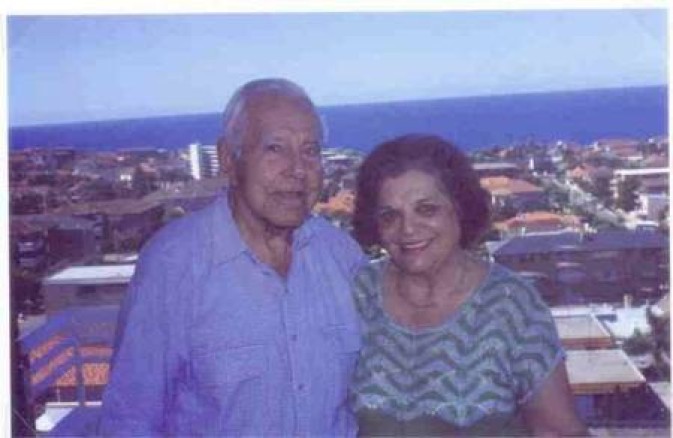Picture Gallery. Chapt 7. of KEVIN CORK's Ph.D thesis. Photograph 4: Mr and Mrs Nicholas Andronicos, Sydney, 1996.
Photo 4:
Mr and Mrs Nicholas Andronicos, Sydney, 1996.
During the 1990's KEVIN CORK undertook extensive research into cinema's in Australia.
Tragically, he died before completing his work, but most of the chapters of his Ph.D. Thesis, were completed.
His wife and children have kindly given permission for his work to be reproduced.
Most Australian's would be unaware of the degree to which Greeks, and particularly Kytherian Greeks dominated cinema ownership in Australia - especially in New South Wales.
Chapter 7 of Kevin's thesis, is his attempt to provide a more intimate insight into the character and lives of the Hellenes and Kytherians, who owned, and operated cinema's in New South Wales in the pre-television era. Also to highlight the Cinema's themselves - and their importance in the Hellenic and Kytherian heritage in NSW, and Australia. This has been achieved by providing photographs of people and place.
The Chapter, in written form, flows as one piece. At kythera-family, I am posting the entries, photograph by photograph.
Kevin's Picture Gallery project was never completed. It was obviously meant to be far more extensive than appears in the uncompleted manuscript; designed to chronicle the lives of all Greeks and Kytherians mentioned in the thesis.
It is incumbent on Kytherians, and Australians, generally; in particular the descendants of those who have been the subject of his thesis, to help complete this project by posting the "additional" photographs to the web.
In the meantime, all photographs mentioned in Kevin's Picture Gallery section have been "tracked down", and posted to kythera-island.
The the importance of the Hellenic and Kytherian contribution to Australian cinema ownership and history is clearly demonstrated in Chapt 7, as in all other chapters.
It is difficult to know how to pass on to Kytherians the results of Kevin Cork's important research's.
In the end, I felt that the results should be passed on in the most extensive way - i.e. in full re-publication of Chapter's.
Eventually all Chapters will appear on the kythera-family web-site.
Other entries can be sourced by searching under "Cork" on the internal search engine.
See also, Kevin Cork, under People, subsection, High Achievers.
Special thanks to Julie Lee, (nee, Cork), Kevin's daughter, who painstakingly searched for the photographs referred to in Chapter 7; found, collated, and supplied them to me in electronic format. [See entry under Julie Lee.]
As she commented: "Finally we've found all the photos! It was very interesting to go through a lot of Dad's research to find these, but I think it was worth it. I can't believe how many drafts he had done of his thesis just to get to the point he finished at".
Chapter 7: Picture Gallery
"What a pity that humans, collectively, have not been endowed with more foresight than hindsight! There'd be more pride in the preservation of our heritage in all fields of endeavour."
"A picture says a thousand words", goes the old saying. This chapter is a photograph album, put together to show what the members of the subject group achieved. Photographs of the men and, in some cases, their wives and families, appear on the following pages as a record to show who they were. Some show people as they were many years ago, at the height of their picture-show days, while others show them as they were a year or two ago when the writer interviewed them. Also included are photographs of the picture theatres that they operated. Photographs of their refreshment rooms and streetscapes of the towns in which they worked are also presented, although these are more of a rarity.
The photographs come from a variety of sources, including the albums of former exhibitors and/or their families. Normally, they would never be seen outside of family circles. The writer was privileged to be permitted to have copies taken from them and to reproduce them here. The sources of all photographs have been acknowledged.
When one looks at streetscape photographs of Walgett and Lake Cargelligo in the 1930s, the architectural statement made by the new theatres is one of vibrancy - they cannot help but be noticed. Yet, there is a sadness associated with them. Picture theatres were meant to be seen at night, but were rarely photographed at night. C Day Lewis, in his poem Newsreel (1938), refers to the picture theatre as "the dream-house" - a place where dreamers can leave "your debts asleep, your history at the door". These buildings have an ambience which evolved because of what they represented. They were places where people socialised and were entertained. (In the case of some country theatres, they were also used for dancing.) The daytime snaps of picture theatres show prominent buildings but do not capture the magic of the buildings that was created once the sun had gone down and their lights came on. This was when they drew patrons to them who were eager for a night of socialising and entertainment. In her poem, Magic, Dorothea Mackellar writes,
"Would you see some magic?
Watch what comes to pass..."
She was writing about trams, not theatres, but the sentiment is the same. By day, trams were just trams. At night, with their lights on and with sparks flashing from their poles, they became "jewelled beetles" scurrying through the dark. Night time was the best time for picture theatres because their dimensions became blurred against the darkness that surrounded them and the only way to view them was by the aid of artificial lighting which, in turn, helped to create the magic associated with them.
With so many of the theatres demolished or altered, the photographs presented on the following pages are the only permanent record of what the men in the subject group achieved.
